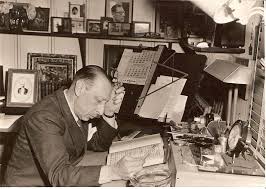Igor Fyodorovich Stravinsky Biography
Igor Fyodorovich Stravinsky was a seminal figure of the early- and mid-twentieth century musical world far beyond his birthplace near St. Petersburg. As a cosmopolitan in the broadest sense, holding Russian, French, and American citizenships at various times of his life, Stravinsky’s influence was far-reaching.
Igor Stravinsky was born in the town of Oranienbaum, Russia, in 1882, and was raised in the city of St. Petersburg. His father was an operatic bass at the Maryinsky (now Kirov) Theatre in St. Petersburg, and his mother was an accomplished pianist. While Stravinsky studied piano and music from an early age, his parents wished for him to pursue another vocation. He entered law school in 1901 upon graduation from secondary school. 
Another important association for Stravinsky began in 1909. Two of his compositions were performed at a concert in St. Petersburg, a concert attended by ballet impresario Sergei Diaghilev, who had just organized a ballet company in Paris, the Ballets Russes. Diaghilev commissioned Stravinsky for a full-length ballet, The Firebird.
The success of Firebird led to the 1911 ballet Petrouchka, and the 1913 ballet The Rite of Spring, which famously inspired a riot on its opening night.


Stravinsky sailed for America in September of 1939 to fulfill his Harvard commitment, and Vera followed after in January of 1940. They were married in March and settled in West Hollywood, California. Stravinsky became a naturalized American citizen in 1945 and lived in California longer than any other location. He soon became a fixture in his adopted community, building relationships with other ex-patriates who settled in Los Angeles, including Otto Klemperer, Thomas Mann, Franz Werfel, George Balanchin, Aldous Huxley, and Arthur Rubinstein. He returned to Russia as a guest of the Soviet government, meeting with composers Aram Khachaturian and Dmitri Shostakovich, among others. Stravinsky relocated to Manhattan in 1969, and lived there until his death in 1971. He is buried in the cemetery of San Michele in Venice, next to his friend and colleague Sergei Diaghilev.
Stravinsky’s career spanned a large part of the twentieth century, 1909-1971, and encompassed a variety of styles. Historians typically divide his output of more than 100 compositions into three stylistic periods: all date ranges are approximate as the lines between “periods” is not distinct. 1907-1919 is considered Stravinsky’s “Russian” period, since many of the significant works from this era are ballets or other theatre works based on subjects from Russian folklore. The music of this time is lushly orchestrated, owing to the influence of Rimsky-Korsakov. The Firebird, Petrouchka, and The Rite of Spring are the most well-known works from this period.
1920-1954 heralded Stravinsky’s return to the formalism and structure of the Classical period, with his works strongly influenced by the music of Mozart, Haydn and other composers previous to 1800. Please visit the chapter on Neoclassicism for more information and examples of this style, which culminated in The Rake’s Progress. His final compositional period, 1955-1968, was marked by experimentation with the twelve-tone techniques developed by Arnold Schoenberg. The first significant work from this final period was In Memoriam Dylan Thomas, for tenor, string quartet and 4 trombones, and other important works include Threni, a cantata, and the Variations for Orchestra.
For a comprehensive list of works by Igor Stravinsky, visit http://www.boosey.com
Materials prepared by Dr. Carol Anderson








